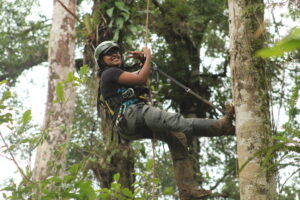
As part of our SENACYT funded grant, Claudio Monteza and Lilisbeth Rodríguez-Castro have led a project to uncover the seed dispersers of the only known epiphytic gymnosperm, the Panamanian cycad Zamia pseudoparasitica. They set arboreal camera trapping between October 2019 and March 2020 in three sites in Central Panama, yielding an accumulated survey effort of 271 camera days. They tracked a few focal ovulate (“female”) plants of the species to find out who’s visiting the open cones – full of seeds. Among the visitors, they uncovered toucans, monkeys and opossums.
However, the most frequent visitor was the Northern Olingo, a quite charismatic arboreal mammal. The Olingo was seen transporting many of the seeds in its mouth. However, as any great study, they have more questions than answers: Is the Olingo the obligate seed disperser? Are the Olingos the only animals eating Zamia seeds? What’s the genetic neighbourhood of the plant and the disperser ? Many questions and they hope to answer most of them !!
As they conclude in their paper: “The interaction between Northern olingo and Z. pseudoparasitica provides a fascinating system to investigate co-adaptations and evolutionary interactions between a plant and its seed dispersers, which may improve our understanding of the lifecycle of this rare and unique epiphytic gymnosperm.”
Here is the paper and a short video on the findings:
Media coverage:
https://www.earth.com/news/solving-the-mystery-of-how-zamias-live-in-the-forest-canopy/
https://www.dicyt.com/noticias/el-misterio-de-la-dispersion-de-una-extrana-planta-panamena
https://stri.si.edu/story/caught-red-handed